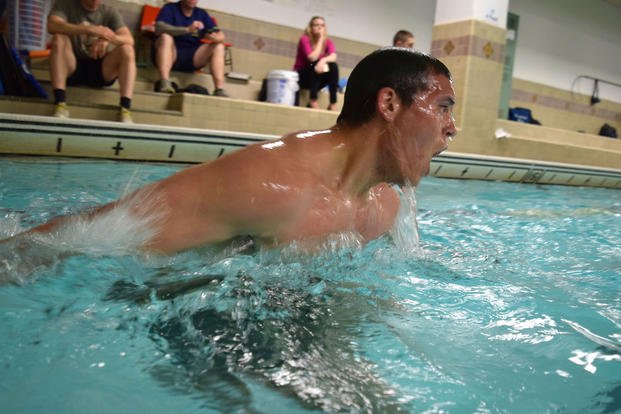There are several military swimming-related tests most military members must be able to pass. Usually, these tests are either performed at the various military indoctrination training programs throughout the branches or in advanced training, such as that performed in special forces. However, in the Navy and Coast Guard, the swim test is part of the physical testing that members receive biannually, usually a 500-meter or 12-minute swim test.

First of all, no matter who you are, never swim without a lifeguard or swim partner when training in the pool.
If you are having a tough time being comfortable in the water, the only way to get over this feeling is to practice being in the water. Start off treading water, hold your breath for a few seconds underwater and move slowly with as little effort as possible. This will help you find your balance in the water. Most people do not balance themselves properly in the water and will struggle to swim one pool length.
To learn balance, watch swimmers swim past you for a while, and if you need instruction, you can get it from most pools or through Total Immersion Swim Training. These folks have swimming stroke drills for free and for purchase, which can help with long-distance swims.

One of the toughest swims I receive emails for on a weekly basis is the underwater swim, especially from Navy SEAL and Air Force PJ candidates. When swimming underwater, once again, never do it alone. There have been many people who were great swimmers but have died from shallow water blackout, defined at the Navy Safety Center as decreased oxygen levels leading to unconsciousness.
Before swimming underwater for various military tests, do not hyperventilate. Take one big inhale, then one big exhale, followed by a big inhale. Doing this several times will be hyperventilating; do not hyperventilate. Limit inhales to only two, then kick off the wall and glide as much as you can.
The pictures provided here illustrate the process of efficiency when swimming underwater.
Related Videos:
What is the Combat Swimmer Stroke?
Stew Smith's Combat Swimmer Stroke DVD
500 Yard Combat Swimmer Stroke
Two specwar candidates break 8 min in the full 500yd swim using the CSS. Read more.
More swimming articles:
- Helicopter Rescue Swimmer Training
- Popular Swimming Pool Workouts
- Rescue Swimmer Fitness Standards
- Summer Swimming Workouts
- Swimming With Fins
- Swimming Without Water
- Video: The Combat Swim
- The Combat Swim
Stew Smith is a former Navy SEAL and fitness author certified as a Strength and Conditioning Specialist (CSCS) with the National Strength and Conditioning Association. Visit his Fitness eBook store if you're looking to start a workout program to create a healthy lifestyle. Send your fitness questions to stew@stewsmith.com.
Want to Learn More About Military Life?
Whether you're thinking of joining the military, looking for fitness and basic training tips, or keeping up with military life and benefits, Military.com has you covered. Subscribe to Military.com to have military news, updates and resources delivered directly to your inbox.



















